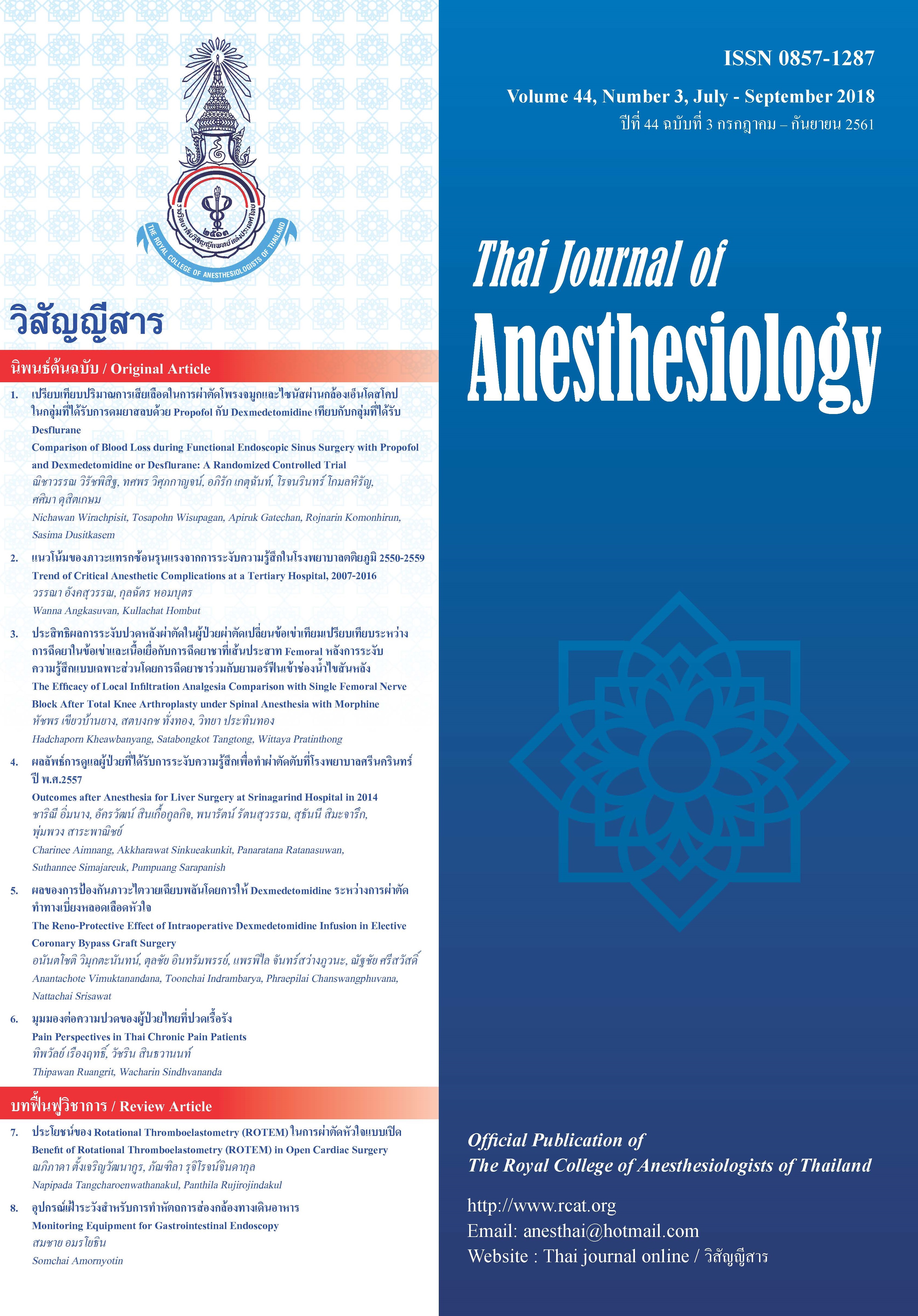อุปกรณ์เฝ้าระวังสำหรับการทำหัตถการส่องกล้องทางเดินอาหาร
Main Article Content
บทคัดย่อ
Patient monitoring is intended to decrease the risk of anesthesia-related complications. All patients receiving anesthesia to facilitate gastrointestinal endoscopic procedures should have monitoring of cardiorespiratory parameters before, during and after the procedure. A wide range of monitoring equipment is available to support the use of anesthesia with gastrointestinal endoscopy. Endoscopic patients undergoing sedation have their oxygen saturation, pulse and blood pressure monitored throughout the procedure. Additionally, several guidelines now recommend capnography monitoring as a standard for patients
undergoing moderate to deep sedation in endoscopy. Electronic monitoring may detect early signs of patient distress and discomfort. Early detection of anesthesia-related adverse events could be done. However, electronic monitoring is an adjunct to continuous clinical assessment. It could not replace continuous clinical assessment. According to anesthesia safety, this present short review aims to describe and highlight monitoring equipment for gastrointestinal endoscopy.
Article Details
เอกสารอ้างอิง
2. American Society for Gastrointestinal Endoscopy. Monitoring equipment for endoscopy. Gastrointest Endosc 2013;77(2): 175-80.
3. Amornyotin S. Sedation and monitoring for gastrointestinal endoscopy. World J Gastrointest Endosc 2013;5(2):47-55.
4. Amornyotin S. Anesthesia innovation: Mini-review of an intravenous sedation for gastrointestinal endoscopy. Adv Res Gastroenterol Hepatol 2017;4(3):ARGH.MS.ID.555636.
5. American Society of Anesthesiologists. Practice guidelines for sedation and analgesia by non-anesthesiologists-an updated report by the American Society of Anesthesiologists Task Force on sedation and analgesia by non-anesthesiologists. Anesthesiology 2002;96(4):1004-17.
6. Amornyotin S, Pranootnarabhal T, Chalayonnavin W, Kongphlay S. Anesthesia for gastrointestinal endoscopy from 2005-2006 in Siriraj Hospital: a prospective study. Thai J Anesthesiol 2007;33(2):93-101.
7. Amornyotin S, Aanpreung P, Prakanrattana U, Chalayonnavin W, Chatchawankitkul S, Srikureja W. Experience of intravenous sedation for pediatric gastrointestinal endoscopy in a large tertiary referral center in a developing country. Pediatr Anesth 2009;19(8):784-91.
8. Amornyotin S, Kachintorn U, Chalayonnawin W, Kongphlay S. Propofol-based deep sedation for endoscopic retrograde cholangiopancreatography procedure in sick elderly patients in a developing country. Ther Clin Risk Manag 2011;7:251-5.
9. Amornyotin S, Srikureja W, Pausawasdi N, Prakanrattana U, Kachintorn U. Intravenous sedation for gastrointestinal endoscopy in very elderly patients of Thailand. Asian Biomed 2011;5(4):485-91.
10. Krugliak P, Ziff B, Rusabrov Y, Rosenthal A, Fich A, Gurman GM. Propofol versus midazolam for conscious sedation guided by processed EEG during endoscopic retrograde cholangiopancreatography: a prospective, randomized, double-blind study. Endoscopy 2000;32(9):677-82.
11. Punjasawadwong Y, Phongchiewboon A, Bunchungmongkol N. Bispectral index for improving anesthetic delivery and postoperative recovery. Cochrane Database Syst Rev 2014;Issue 6,CD003843, doi:10.1002/14651858.
12. Matsumoto K, Nagahara A, Matsumoto K, et al. Optimization of deep sedation with spontaneous respiration for therapeutic endoscopy combining propofol and bispectral index monitoring. Gastroenterol Res Pract 2015;Article ID 282149,6 pages. http://dx.doi.org/10.1155/2015/282149.
13. Park SW, Lee H, Ahn H. Bispectral index versus standard monitoring in sedation for endoscopic procedures: a systematic review. Dig Dis Sci 2016;61(3):814-24.
14. Amornyotin S, Chalayonnawin W, Kongphlay S. Deep sedation for endoscopic retrograde cholangiopancreatography: a comparison between clinical assessment and NarcotrendTM monitoring. Med Devices (Auckl) 2011;4:43-9.
15. Amornyotin S, Srikureja W, Chalayonnawin W, Kongphlay S. Dose requirement and complication of diluted and undiluted propofol for deep sedation for endoscopic retrograde cholangiopancreatography. Hepatobiliary Pancreat Dis Int 2011;10(3):313-8.


